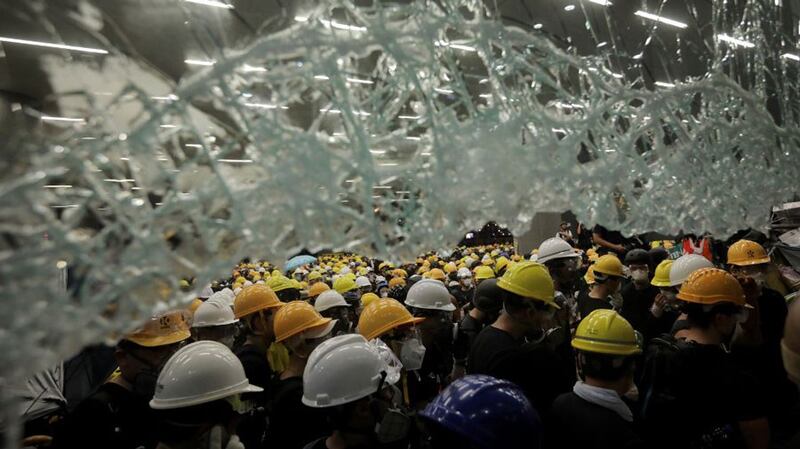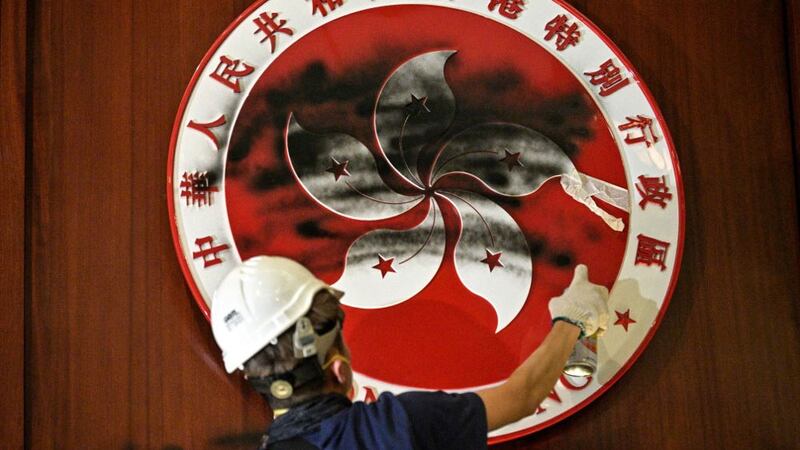UPDATED at 2:20 p.m. EDT on 2019-07-01
Hong Kong police fired tear gas late on Monday to disperse a large crowd of anti-extradition protesters who stormed the city's legislature, daubing the interior with protest banners and graffiti and hanging the flag of pre-1997 Hong Kong at the speaker's dais.
Large crowds began running from area around the Legislative Council (LegCo) as police in full riot gear began an operation using tear gas to clear protesters from the building, the area outside, and nearby Harcourt Road, livestreamed video footage showed.
Police hoisted warning signs to the crowd to disperse, before firing multiple rounds of tear gas, reaching the smashed glass doors and buckled security shutters of the legislature, where the crowd of anti-extradition protesters had surged through earlier in the night, shortly after midnight, government broadcaster RTHK reported.
"The LegCo building was violently attacked and [forcibly entered] illegally," the force said. "The police will conduct clearance operations shortly, and will use reasonable force ... and [we] appeal to [other] protesters to leave the vicinity."
As night fell, hundreds of anti-extradition protesters in Hong Kong stormed the building after huge crowds once more took to the streets to protest against plans to allow extradition to China, smashing through the reinforced glass with metal objects ripped from the nearby streets over several hours.
Clad in yellow construction helmets and using swimming floats strapped to their arms as shields, the protesters surged into the building after a long face-off with police in full riot gear, who appeared at first to offer no resistance.
Earlier, amid shouts of "Withdraw! Withdraw!", huge numbers of people joined a peaceful march that saw about half a million people come out against planned amendments to the Fugutive Offenders Ordinance that would allow alleged criminal suspects to be sent to mainland China to face trial.
Many marchers revived calls for fully democratic elections in the city. The ruling Chinese Communist Party ruled out such a move in 2014, sparking the 79-day Occupy Central movement.
Some chanted: "Genuine Universal Suffrage! Withdraw the Evil Law!" while others held up placards calling on chief executive Carrie Lam to to resign following weeks of mass protests at her plans to allow the rendition of alleged criminal suspects to mainland China.
Lam last month announced the plans would be shelved indefinitely, but stopped short of withdrawing them entirely, prompting fears that Beijing will insist the government try again when protests have died down.

Public anger inttensifying
Marchers, who included people of all age groups including families with children, took up six lanes along the main route, in a turnout that appeared similar to video footage of the million-strong anti-extradition march of June 9.
Jimmy Sham, convenor of march organizers the Civil Human Rights Front, said the protesters' demands remain the same: to fully withdraw the amendments instead of merely postponing them; to order a public inquiry into police violence against unarmed protesters on June 12; to drop official wording describing that day's protests as a riot, as well as dropping all charges against previously arrested protesters.
"Yes, we saw a lot of clashes and conflicts today," Sham said, prior to the storming of the legislature. "What we are witnessing is public anger that is getting more and more intense."
A marcher surnamed Wong said she witnessed the protesters smashing the glass doors of LegCo.
"About half of the glass doors were smashed; there were so many people here," Wong said. "The numbers were about the same as on the million-strong march [of June 9]."
And a marcher surnamed Woo said that the majority on the peaceful demonstration wouldn't have agreed with the storming of LegCo.
"I think that this was just a small minority of Hong Kong people who would want to do such a thing," Woo said. "We should pursue those responsible ... but that the same time, what are we going to do to protect demonstrators from police violence?"
"The June 12 protesters were hit with so many tear gas canisters ... I think both sides should stop now," he said. "We need an independent inquiry with senior judges that will give the opportunity to rebuild mutual trust."
Protesters outside LegCo called on marchers to join the siege of the building as the march--which began at Victoria Park at 2.00 p.m. local time--continued to file into the area, lit by smartphone flashlights, long after nightfall.
Others occupied Harcourt Road, a major highway running past the government and legislative compound, closing it to traffic.
Deliberate ploy by the authorities?
Live video streams from the scene showed police in full riot gear waiting inside the LegCo building, as protesters clad in yellow construction helmets and wielding umbrellas gathered outside to cheer on protesters who took turns to smash holes in the building using metal traffic barriers and aluminium cladding removed from the building over several hours.
Police inside the building raised a red warning flag, which sometimes precedes the firing of tear gas and rubber bullets, but no tear gas was fired and protesters met with no resistance when they finally entered the building.
Labour Party lawmaker Fernando Cheung said the move had been a deliberate ploy by the authorities to ensure that shocking images of a wrecked LegCo reached the world's media.
"This is a trap," Cheung, who was present at the time, told government broadcaster RTHK. "The protesters this morning who were storming LegCo could have been dispersed easily by the police. They were not a large number, we're talking about probably a few hundred people. And those who were actually taking action were even smaller in number. And yet the police did not do anything."
"They wanted this to happen. They wanted the public to see this," Cheung said.
Earlier in the day, protesters had also removed the flag of the People's Republic of China from a ceremonial flagpole outside the city's exhibition center, replacing it with a blackened flag of Hong Kong flown at half-mast, as the city marked the 22nd anniversary of its return to Chinese rule, a day that was deliberately chosen to coincide with the anniversary of the ruling Chinese Communist Party's founding in 1921.
Police had also been filmed beating some protesters with batons as they pushed towards the Convention and Exhibition Center, with social media posts showing photos of protesters with bleeding from head wounds, and amid reports of multiple calls for ambulances.
Rescue services said two police officers received hospital treatment after a chemical substance was reported at the entrance to LegCo at around 3.34 p.m., and that a hazardous materials team had identified the substance as P-phenylenediamine, which can cause itchy eyes, skin redness and swelling, and shortness of breath.
Inhalation of large amounts of the substance may also cause serious skin and respiratory tract burns, the statement said.
Chief executive Carrie Lam and Chinese dignitaries who usually attend a July 1 flag-raising ceremony marking the 1997 handover stayed away.

'Failed' Carrie Lam administration
The Hong Kong government said it "strongly condemns and deeply regrets the extremely violent acts committed by some protesters who stormed the Legislative Council (LegCo) Complex this afternoon."
In a statement on its official website, it said protesters had used "a roll cage trolley as a ram and iron poles to shatter glass doors." Government headquarters will remain closed on Tuesday, according to a separate statement.
But the pro-democracy Civic Party said Lam should resign, adding that hers was a "failed" administration that should have listened to the demands of the protesters.
"Since June 9, the people of Hong Kong have made their demands very clear to the [Hong Kong] Special Administrative Region government in a number of different ways, which hid from them for days, holding private meetings with the Chinese Communist Party and the police, showing their contempt for public opinion," the party said in a statement on its Facebook page.
"[This] triggered the mass protests on July 1," it said. "Responsibility for the serious conflicts caused by public anger and the despair of the young people lies with Lam's administration, which has remained blinkered and insensitive, pushing Hong Kong to an unprecedented sociopolitical crisis."
The protest was the latest in a string of mass actions in recent weeks, amid growing anger over the extradition amendments, and the use of tear gas, rubber and textile bullets, pepper spray and batons by police on unarmed protesters on June 12.
The amendments are widely seen as a threat to Hong Kong's way of life, which was supposed to have been protected by the "one country, two systems" framework under which the former British colony was handed back to China in 1997.
If they become law, the city could lose its status as a separate legal jurisdiction and trading entity, while journalists, visitors, rights activists, dissidents, democratic politicians, and members of the business community could be targeted for words and actions deemed illegal by Chinese authorities, and extradited to face trial in Chinese courts.
Pro-democracy lawmakers say the only solution to recurring mass protests in Hong Kong is for the government to allow fully democratic elections, a demand that was rejected by Beijing in 2014, sparking the Occupy Central, or Umbrella Movement.
Hong Kong's lawyers have also come out in support of protesters, saying that the extradition bill should be withdrawn completely, as opposed to the postponement offered by Carrie Lam last month.
Reported by Wen Yuqing for RFA's Cantonese Service, and by Qiao Long for the Mandarin Service. Translated and edited by Luisetta Mudie.
